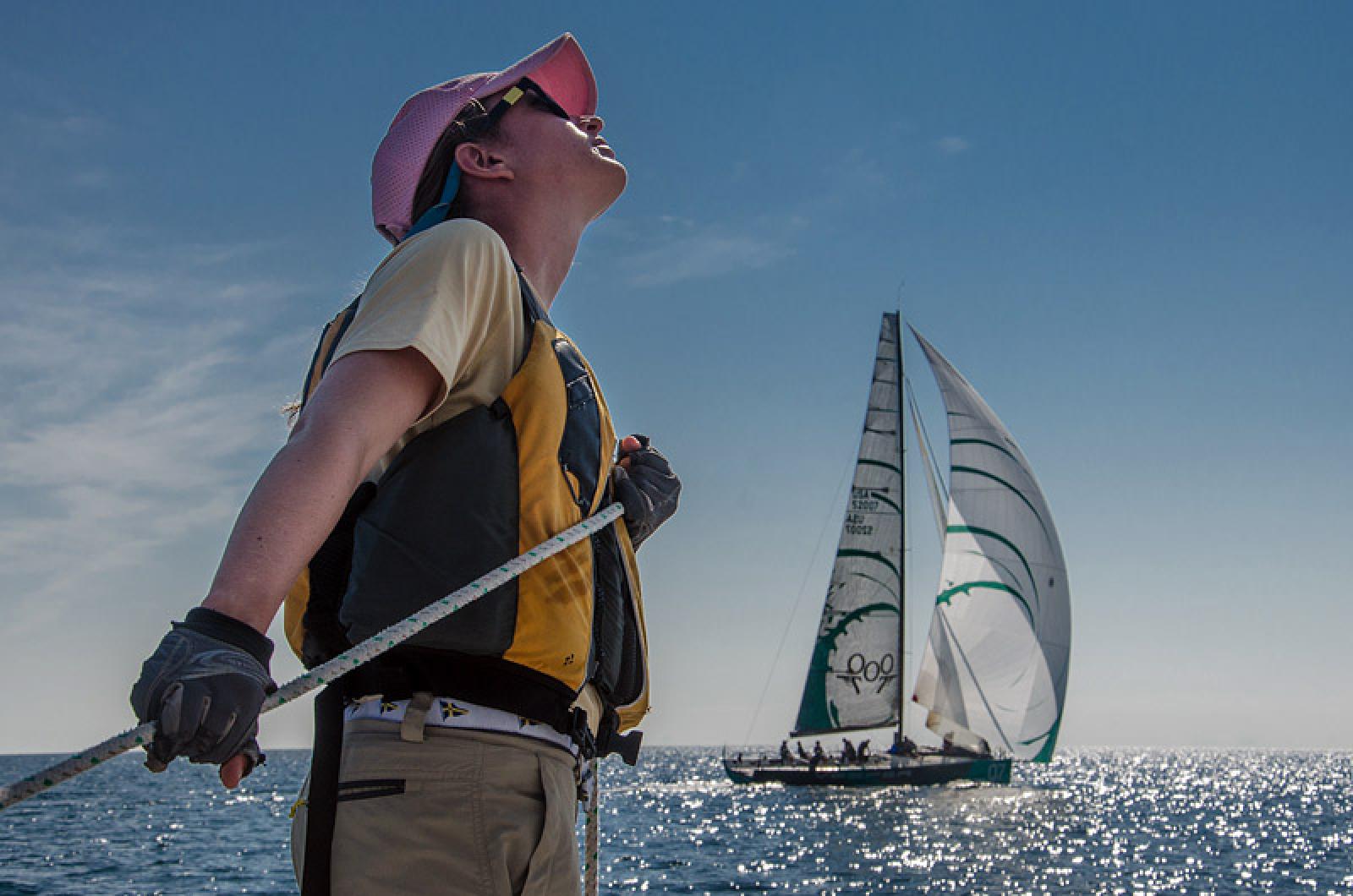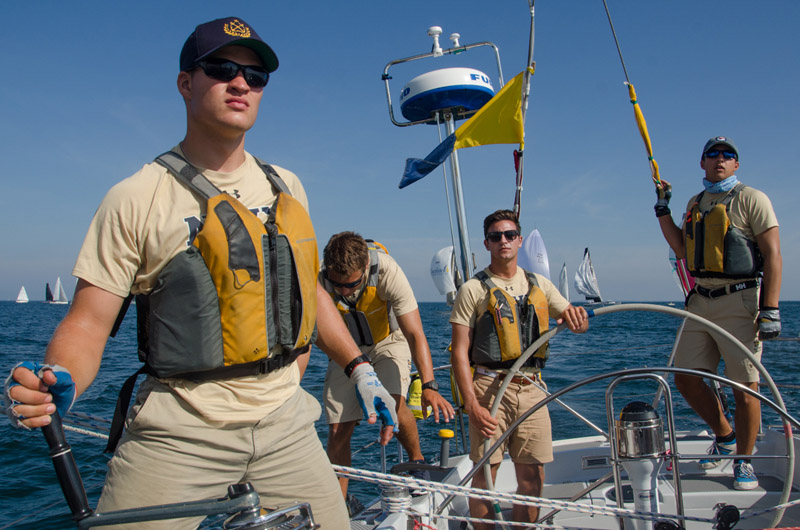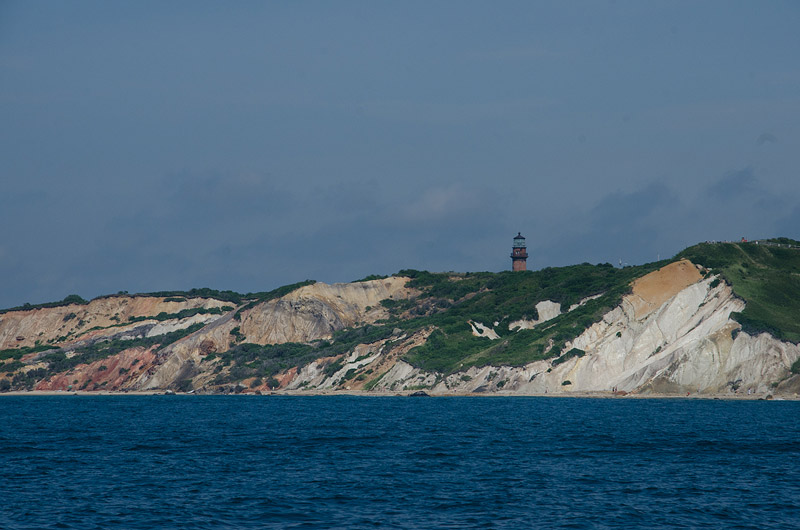A leach cord on the staysail needed adjusting. It was too tight, slightly distorting the edge of the relatively small sail, as the U.S. Naval Academy varsity offshore sailing team competed in the 79th Round the Island Race Saturday. It is the kind of thing that can cost you, maybe, a tenth of a knot in boat speed. Maybe.
Lieut. Josh Hinshaw, a coach for the Naval Academy team, called for an adjustment. The crew couldn’t reach the leach cord from the deck. Lieut. Hinshaw suggested someone get in a bosun’s chair, clip on to a free halyard, and be hoisted out over the water as the boat raced along the course at about six knots.
Several midshipmen began a discussion about different, perhaps easier ways to fix the problem. Most of them involved furling the sail, which might have cost the boat a full knot of boat speed for a few seconds.
“C’mon guys, I’m serious,” Lt. Hinshaw said. “It’s not that big a deal.” It’s his job to help the crew sail fast, but it’s also his job to teach, to demand, leadership.
No one ordered midshipman Ryan Pinch to duck below deck, but he did, and emerged a few seconds later with a bosun’s chair strapped around him. He moved forward and clipped on a halyard. A couple of crew members moved into position on the winch.
“I’ll jump and you catch me,” midshipman Pinch said.
What he was proposing was that, rather than the crew haul him aloft slowly, he would jump as high as he could, and the crew would quickly take up the slack in the halyard, holding him about three feet above the deck, where he could swing out over the water.
He jumped. They held. He swung out over the water, quickly adjusted the leach cord, and the crew hauled him back on deck.
The maneuver took discipline, skill, courage and leadership. Apparently they teach those qualities pretty well at the Naval Academy.
The midshipmen chose Edgartown Yacht Club race week to cap a 45-day adventure that took them from Annapolis, Md., to regattas in Newport, Nantucket and Boothbay Harbor before the competition off the shores of Martha’s Vineyard.
The midshipmen are responsible, with minimal guidance, for everything from making sure there is cereal for breakfast, to catching a crew member in a bosun’s chair. They have to keep the Navy 44 training vessel Integrity away from the sharp rocks of Penobscot Bay, and off the tricky shoals of Vineyard Sound. It is one of several summer programs which are part of the Naval Academy education.
“It’s got to be one of the best leadership opportunities in the academy,” said executive officer McKenzie Barnett, a junior from Kodiak, Ala. “Where else does a 21-year-old get to be in charge?”
Light air plagued the fleet as they began the race off Cape Pogue and slogged down East Beach under light spinnaker sails to round the shoals well south of Wasque. Fortunately, a favorable tide helped.
Helmsman Robert LaGuardia Jr., a junior midshipman from New Bern, N.C., was born on the Vineyard and still visits his family’s West Tisbury home. He was steering the boat when a competitor trying to round the first mark appeared to miscalculate, and realized he wasn’t going to make it. They waited too long to steer around Integrity. As the competitor’s bow bore down on the stern quarter, Mr. LaGuardia suddenly wrenched the wheel to starboard, swinging the stern out just enough to allow the competitor to clear Integrity. No exaggeration, the quick thinking and sure reaction avoided a dangerous collision — by an inch.
The agile helmsman counts these kinds of close calls as a learning experience.
“I think it’s the best opportunity that I’ve found to take the leadership lessons we’ve learned and apply them,” Mr. LaGuardia said. “We literally depend on each other for our lives.”
The boats finally turned along the south shore of the Vineyard, still flying spinnakers, chasing tiny veins of shifting wind that showed themselves in thin strips of darker water. Those who found them were rewarded. Being in the right place at the right time sometimes meant a half-mile advantage.
Integrity caught her share of the puffs, and the Naval Academy team found themselves near the front of the pack as the boats rounded Squibnocket Point.
At the command of skipper Mike Sagan, a junior from Columbia, N.J., the team changed sails often, hoping to gain a small advantage. Some sails took enormous effort to set and were doused after a few minutes because of a wind shift, only to be hoisted again on the next shift. There was never a moment’s hesitation, or an order questioned. In a 52-mile race the skipper makes hundreds of decisions. Any one of them could win or lose the race, and any lapse in execution can cost dearly.
“That’s really hard to do, especially in light wind,” Midshipman Sagan said. “You try to keep the crew focused.”
“If there is one thing midshipmen are good at, it’s endurance,” executive officer Barnett said.
Rounding Gay Head and setting a course up Vineyard Sound, the breeze picked up to 12 knots and shifted further, allowing the crew to keep a spinnaker flying. But the heavier wind made every maneuver a little more difficult, and the deck was suddenly a flurry of coordinated action. The light white spinnaker came down, a heavier spinnaker, in the blue and gold Navy colors, went up as the breeze freshened. Integrity dodged a ferry off West Chop and then dodged another one off East Chop, before bearing toward the finish, close hauled, right on the edge of the wind. Up ahead, Midshipman Sagan spotted a boat in his class crossing the finish line. He estimated they were about 11 or 12 minutes ahead. He also knew the boat was rated faster, and would have to yield about 11 minutes to Integrity when handicaps were applied. In other words, at that moment in the race, they were just about tied.
That leadership thing kicked in and the skipper rallied his crew.
“Seconds count,” he said. “Let’s keep sailing fast.”
Midshipman Barnett posted two underclassmen forward, to call every wind puff back to the helm.
Bearing down on the line, Midshipman LaGuardia steered the bow up into the wind at the last moment, trying to shave a second or two off the elapsed time at the finish line.
After more than nine hours of intense sail racing, Integrity finished second in class by 37 seconds on corrected time, after handicaps were applied. The Naval Academy entry was 11th over the line in the fleet of about 70 boats, including many rated much faster.
In Thursday and Friday racing, Integrity was a perfect seven for seven, winning every race they entered on windward/leeward courses around buoys in Nantucket Sound. On Saturday they fell a few seconds short of winning their eighth race in three days.
There was no cheering as Integrity motored back to the Edgartown harbor. The midshipmen knew they sailed extraordinarily well, but seemed unwilling to accept anything less than perfection. They were already analyzing how to improve.
“You know you could have made up those seconds,” Midshipman LaGuardia said. “You think back about how you could have made up those seconds.”
Duty first, fun second.
In boat racing, second is pretty good. They give you a nice shiny trophy.
But these midshipmen understand they are in training to defend the country. In that, they realize, there is no second place.












Comments (12)
Comments
Comment policy »